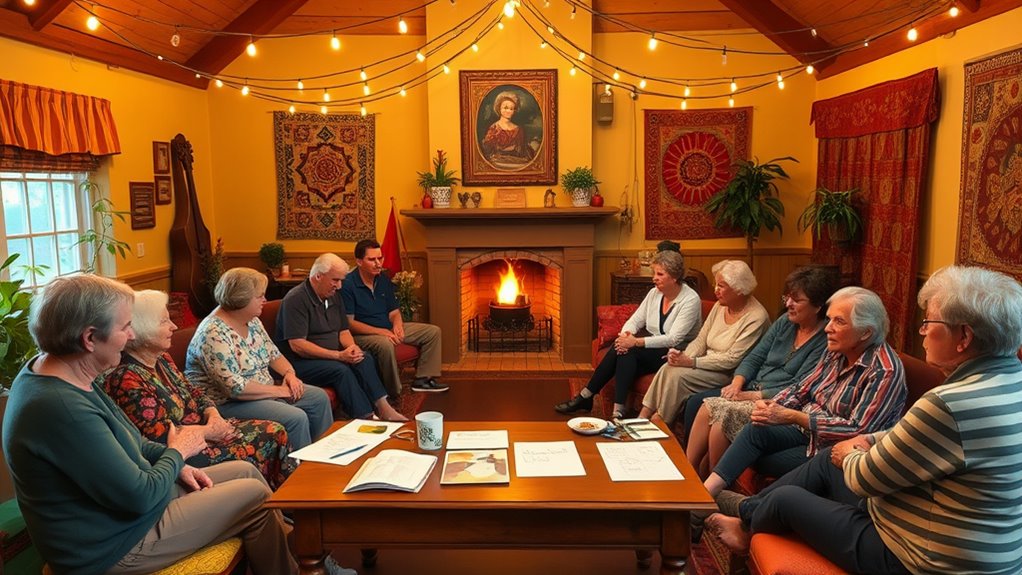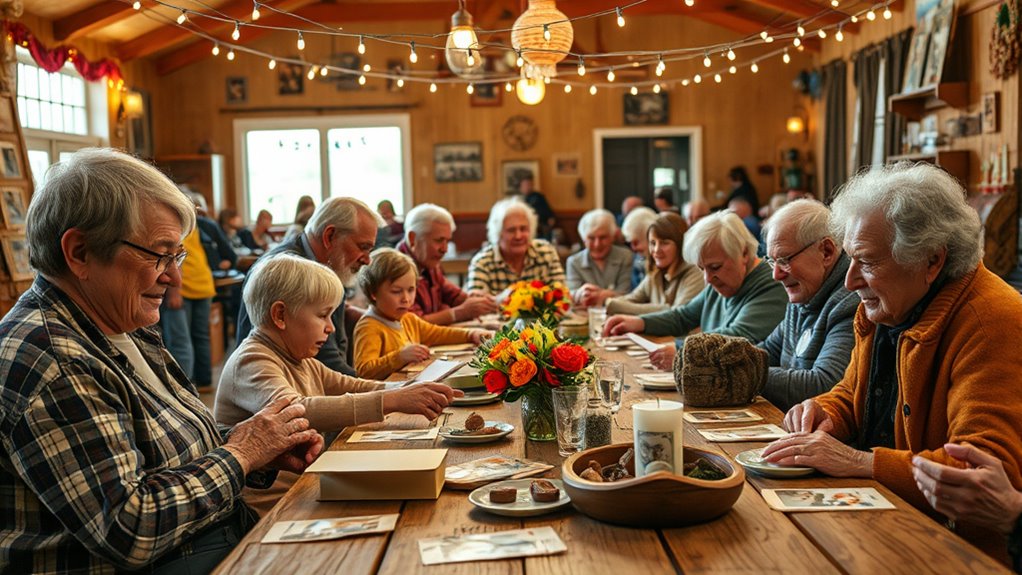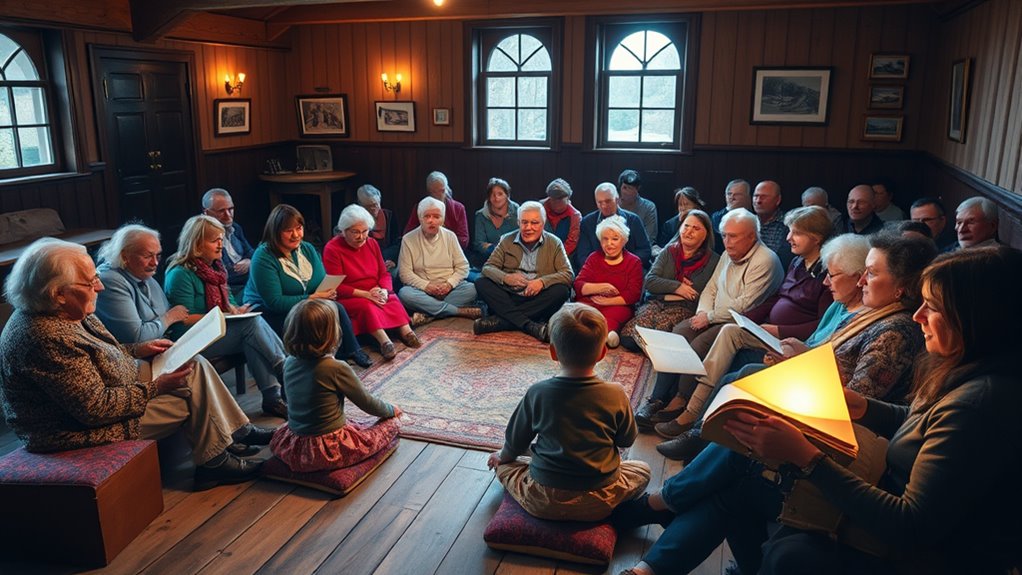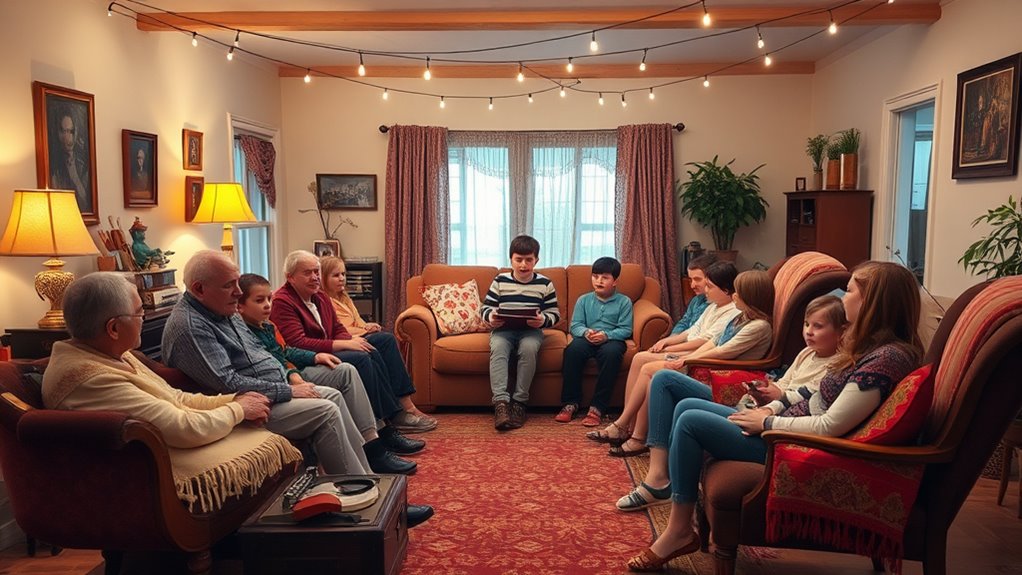To set up an intergenerational storytelling night, start by choosing a warm, accessible venue with comfortable seating and cozy lighting. Invite diverse participants from different backgrounds and ages, encouraging them to share authentic stories. Plan a flexible schedule with creative elements like visual aids or props to keep everyone engaged. Promote the event through local channels and gather feedback afterward. Keep exploring these ideas to learn more ways to create a memorable, inclusive experience.
Key Takeaways
- Create a welcoming, accessible environment with comfortable seating, safety features, and clear guidelines for respectful storytelling.
- Invite diverse participants across generations and backgrounds to enrich the storytelling experience.
- Plan an engaging event format, incorporating creative elements like visual aids, props, or themed dress-up.
- Promote the event through social media, local partnerships, flyers, and word-of-mouth to ensure community participation.
- Collect feedback afterward to improve future events and foster ongoing community engagement.
Choosing the Right Venue and Setting the Atmosphere

Selecting the right venue is essential for creating an inviting atmosphere that encourages open storytelling across generations. Focus on decor lighting that’s warm and soft to foster intimacy and comfort. Bright, harsh lights can be distracting, so opt for gentle lamps or string lights to set a relaxed tone. Seating comfort is equally important; choose chairs or couches that invite guests to settle in and stay awhile. Avoid rigid or uncomfortable furniture that might discourage relaxed conversation. Arrange seating to promote eye contact and easy interaction, making everyone feel included. The venue’s atmosphere should feel welcoming and cozy, encouraging participants to share stories freely. Incorporating elements that promote emotional connection can enhance the overall experience. When you create this inviting environment, you set the stage for meaningful intergenerational exchanges.
Inviting Participants and Encouraging Diverse Stories

Once you’ve created a warm and welcoming environment, the next step is to invite a diverse group of participants. Reach out to different generations, cultures, and backgrounds to guarantee a rich tapestry of stories. Use storytelling techniques that encourage openness, like prompting questions or sharing personal anecdotes, to help participants feel comfortable. Emphasize the importance of cultural diversity and how it enriches the event, inspiring participants to share stories rooted in their unique experiences. Highlight that all stories matter, whether humorous, heartfelt, or educational. By fostering an inclusive atmosphere and emphasizing the value of diverse perspectives, you’ll motivate a wide range of voices to contribute, creating a vibrant and meaningful storytelling night. Incorporating curiosity can invite participants to explore new angles and deepen their storytelling, making the event even more engaging.
Planning the Event Schedule and Format

To guarantee your intergenerational storytelling night runs smoothly and keeps participants engaged, you need to carefully plan the event’s schedule and format. Start by mapping out the event timing, allocating specific time slots for each storyteller to prevent overruns and maintain momentum. Incorporate storytelling techniques that balance different styles, such as personal anecdotes, folktales, or visual aids, to keep the audience interested. Decide whether the event will follow a round-robin format or include themed segments, ensuring variety and inclusivity. Consider breaks to allow for mingling and reflection. A well-structured schedule helps manage expectations and creates a comfortable flow, making the night enjoyable for all ages and encouraging lively participation. Including costume ideas and themed dress-up segments can add an extra layer of fun and engagement for everyone involved.
Creating a Comfortable and Accessible Environment

You want everyone to feel at ease, so choose comfortable seating that suits all ages. Keep noise levels quiet enough to focus without distractions, and make sure the venue is easy for everyone to access. These simple steps help create an environment where stories can be shared freely and comfortably. Incorporating outdoor seating options can also enhance the experience, especially in a scenic location.
Choose Comfortable Seating Arrangements
Selecting the right seating arrangements is essential for creating a welcoming and accessible environment during intergenerational storytelling nights. You want your guests to feel relaxed, so opt for cushioned seating that provides comfort for all ages. Arrange cozy groupings that encourage conversation and connection, such as circular or semi-circular setups. Avoid stiff or overly formal arrangements that might inhibit interaction. Consider including different seating options—chairs, cushions, or even floor seating—to accommodate mobility needs and personal preferences. Keep pathways clear for easy movement, especially for seniors or those with limited mobility. Incorporate natural materials for added warmth and authenticity in the seating choices. The goal is to create a warm, inviting space where everyone feels comfortable, engaged, and ready to share stories. Prioritizing cozy arrangements makes your storytelling night more enjoyable and accessible for everyone.
Minimize Environmental Noise Distractions
Environmental noise can easily disrupt the flow of storytelling and make it difficult for everyone to focus. To create a comfortable atmosphere, implement soundproofing techniques and ambient noise control methods. Use soft materials like rugs, curtains, and upholstery to absorb sound. Consider installing weatherstripping or door sweeps to block noise leaks. Position speakers and microphones carefully to minimize echo and background interference. Additionally, understanding auditory distractions can help you better manage environmental noise during your storytelling event.
Ensure Easy Venue Accessibility
Creating an accessible venue guarantees everyone can participate comfortably in the storytelling night. To achieve this, focus on three key elements:
- Clear venue signage that directs guests effortlessly, reducing confusion and delays.
- Ensuring wheelchair accessibility with ramps, wide doorways, and level flooring to accommodate all mobility needs.
- Designating accessible seating areas close to the stage or speaking area for easy participation.
- Addressing issues related to unrepentant cheating strategies can help create an environment of trust and openness, encouraging honest and meaningful engagement during the event.
Facilitating Engaging and Respectful Sharing

You can foster meaningful sharing by encouraging respectful listening, where everyone feels heard without interruptions. Invite participants to share inclusive stories that reflect diverse experiences and perspectives. By setting these expectations, you create a safe space that promotes engaging and considerate conversations. Incorporating anime culture into storytelling sessions can also inspire creativity and appreciation for different storytelling styles.
Cultivate Respectful Listening
To foster meaningful connections during intergenerational storytelling, cultivating respectful listening is essential. When you practice active listening, you show genuine interest and encourage others to share openly. To create a respectful dialogue, consider these steps:
- Maintain eye contact and nod to show engagement.
- Avoid interrupting; wait until the speaker finishes before responding.
- Reflect on what you hear by paraphrasing or asking clarifying questions.
- Incorporate engaging narratives and immersive soundscapes to make the storytelling more compelling and memorable.
Encourage Inclusive Stories
Encouraging inclusive stories means inviting everyone to share their unique perspectives and experiences. To do this effectively, foster an environment that values storytelling diversity and demonstrates cultural sensitivity. Encourage participants to tell stories from their backgrounds without fear of judgment, emphasizing respect for different cultures and life experiences. Set clear guidelines that promote openness and understanding, ensuring that all voices are heard. Highlight the importance of listening with empathy and avoiding stereotypes or assumptions. By doing so, you create a space where stories can be shared freely and authentically, enriching the intergenerational dialogue. Understanding the safety features of electric heated mattress pads can also help ensure a comfortable and secure environment during storytelling sessions. Remember, inclusive storytelling not only broadens perspectives but also strengthens connections across generations, fostering mutual respect and understanding.
Incorporating Creative Elements to Enhance the Experience

Adding creative elements to your intergenerational storytelling night can transform it from a simple gathering into a memorable experience. Creative touches like interactive props and visual storytelling make stories come alive. To maximize engagement, consider these ideas:
- Use interactive props that listeners can handle or manipulate, making stories more tactile.
- Incorporate visual storytelling with illustrations, puppets, or multimedia displays to captivate all ages.
- Create a themed environment that complements the stories, enhancing immersion and excitement.
These elements encourage participation, spark imagination, and foster connections across generations. By blending storytelling with hands-on and visual components, you keep everyone involved and create a lively, memorable event that resonates long after it ends.
Promoting the Event and Building Community Engagement

Promoting your intergenerational storytelling night effectively guarantees a strong turnout and vibrant community participation. Start with social media outreach by creating engaging posts that highlight the event’s unique aspects and encourage sharing. Use platforms popular in your community to reach diverse audiences, and consider using event hashtags to boost visibility. Additionally, local partnership outreach can expand your reach—collaborate with schools, community centers, and local businesses to spread the word. Distribute flyers, send newsletters, and ask partners to promote the event through their channels. Personal invitations and word-of-mouth are also powerful tools. By combining these strategies, you’ll generate excitement, ensure broad awareness, and foster a sense of community ownership around your storytelling night.
Gathering Feedback and Reflecting for Future Events

After successfully hosting your intergenerational storytelling night, gathering feedback becomes the next essential step. A feedback survey helps you understand what worked and what could improve, ensuring future events are even more meaningful. Start by collecting insights on participant enjoyment, logistical aspects, and storytelling content. Use open-ended questions to encourage honest reflections. Conduct an event reflection with your team to evaluate overall success and identify challenges. This process allows you to celebrate achievements and pinpoint areas for growth. Remember, feedback isn’t just about criticism; it’s a tool for continuous improvement. By actively listening to your community’s responses, you set the stage for more engaging and inclusive storytelling nights that truly resonate across generations.
Frequently Asked Questions
How Can I Ensure Cultural Sensitivity During Storytelling Sessions?
When ensuring cultural sensitivity, you should prioritize cultural awareness by learning about the stories and traditions shared. Use respectful language that honors different backgrounds and perspectives. Encourage participants to share their experiences and listen actively without judgment. Be mindful of stereotypes or generalizations, and ask for permission before sharing personal or cultural stories. This approach fosters an inclusive environment where everyone feels valued and respected during storytelling sessions.
What Are Some Effective Icebreakers for Intergenerational Groups?
You can start with simple icebreakers that encourage sharing family histories or cultural introductions. For example, ask everyone to share a favorite family tradition or a meaningful story from their childhood. These activities help participants connect, foster understanding, and create a welcoming atmosphere. Keep it light and inclusive, allowing everyone to contribute comfortably, which sets a positive tone for the storytelling session.
How Do I Handle Disagreements or Sensitive Topics Respectfully?
When handling disagreements or sensitive topics, remember generational differences can influence perspectives. You should encourage respectful communication by listening actively and validating each person’s feelings. Keep the conversation focused on understanding, not debating, and set clear boundaries if needed. If tensions rise, suggest taking a break or redirecting the discussion. This approach fosters empathy and helps everyone feel heard, promoting a positive and inclusive environment.
What Technology Tools Can Facilitate Storytelling for Remote Participants?
Imagine your stories unfolding seamlessly across screens, connecting distant voices. With virtual collaboration tools like Zoom, you can share multimedia—photos, videos, and audio—turning storytelling into an immersive experience. These tools foster real-time interaction, keeping everyone engaged no matter where they are. By embracing technology, you create a vibrant space where generations weave their tales together, transforming remote storytelling into a powerful, shared journey that bridges distance and time.
How Can I Encourage Shy or Reluctant Storytellers to Share?
To encourage shy or reluctant storytellers, focus on building confidence through gentle encouragement and creating a supportive environment. Use prompts to help them start sharing, making it easier to find their voice. You might ask specific, open-ended questions or share your own stories first, showing vulnerability. Remember, patience is key—give them space and time, and celebrate every contribution to help them feel valued and more comfortable.
Conclusion
By thoughtfully planning each step, you’ll create a memorable intergenerational storytelling night that fosters connection and understanding. Imagine a community where grandparents share stories of their youth, inspiring young adults to appreciate their roots. For instance, a neighborhood event brought generations together through shared tales, strengthening bonds. With your effort, you’ll build a welcoming space where diverse voices are heard, leaving everyone inspired to keep storytelling alive for years to come.









